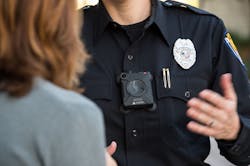How body-worn cameras are driving better outcomes in private security
In a world where every action taken by security officers must be carefully considered, the importance of transparency and certainty can’t be overstated. The wrong move can put organizations or individuals in the headlines for all the wrong reasons. Training and tools that allow security officers to effectively manage tense situations without use of force and video documentation that quickly allows dismissal of false claims is critical for modern security practices. You must be able to provide a look into situations as they happened and easily share that information with law enforcement agencies or the public to dispel any false claims. Body-worn cameras allow security operations to gain a guard-on-the-ground point of view that provides indisputable documentation of any critical encounters. Body cameras are mobile, thereby greatly increasing the flexibility and effectiveness of video coverage provided by fixed cameras. The addition of a roaming, first-person point of view provides better coverage, rapid deployment, enhanced situational awareness, instant scalability, and audio recording.
Furthermore, livestreaming capabilities provide a means for supervisors to monitor and triage tense situations even when they are not physically present. This situational awareness can also act as a force multiplier, enabling the most appropriate response in terms of whether or not to dispatch backup. GPS-enabled hardware allows management operating as incident commanders to ensure proper resource positioning and adapt as needed, whether for an emergency or as a simple need to shift deployment of personnel based on staffing or facility capacity. This also solves the long-standing challenge of proof of presence for widely dispersed security officer forces.
Whether it’s private security, healthcare security, event security or corporate security – body-worn cameras are a proven de-escalation tool that drives better behavior and decreases the likelihood of confrontations. Equipping officers with body cameras all but eliminates the uncertainty that traditionally stemmed from safety incidents or complaints, providing significant reputational risk protections. Body camera video also provides a training tool through real-world video scenarios.
De-escalating Tense Situations
The presence of a body-worn camera can help de-escalate critical situations and gain an ironclad accounting of truth. Put simply, people that know they are being recorded tend to behave better and are far less likely to escalate situations that they know are being captured on video. Whether a security officer dealing with the public or responding to a dangerous situation, scenarios are less likely to escalate when a body camera is present. Studies across several agencies have shown anywhere from a 47% to 75% reduction in use of force when a body camera is present.
Decreasing Complaints
Organizations that use body cameras to capture video data are also increasing accountability and gaining transparency into critical situations. Video documentation means there are no longer “he-said-she-said” situations and lack of certainty on exactly what happened. Just as importantly, complaints drop drastically when a body-worn camera is present as a significant number of complainants are less likely to file a grievance when they understand their own behavior has been documented with video and audio.
In one healthcare study, for example, results showed that the transparency provided by body cameras equated to $4 saved in litigation costs for every $1 spent on body-worn cameras.
Gaining Transparency
Additionally, video documentation ensures that verifiable evidence exists in cases of audits or litigation. Connected body cameras require minimal training and automate the capture and upload of data. Aggregating important video, audio, image, and text assets into a single incident management system makes it simple to sort, manage and share data when the truth of a critical incident needs to be made clear. A video management system can also provide a chain of custody that ensures any data being shared with law enforcement or other agencies is completely reliable.
Enhancing Training
Video is an effective training tool to share best practices or dangerous mistakes made in real-world scenarios that can be used to more effectively and quickly train new employees. It can also be used to improve employee skills and behaviors through reviewing video with staff for coaching purposes. Using video of actual encounters is one of the best tools available to train an entire staff to be safer, more empathetic and effective in the field. Virtual reality training also enables staff to encounter real-world scenarios in a risk-free environment.
For decades, body-worn cameras and video management systems have provided protection and transparency to some of the most critical interactions on earth. These solutions increase efficiency and provide peace of mind and reduced liability to ensure your business operates smoothly and that your officers are as safe and effective as possible.
Brian M. Stephens is the Senior Managing Director for Teneo Risk Advisory.



